Key takeaways:
- Hospital ministry combines spirituality and healthcare, emphasizing the importance of emotional support and understanding patients’ fears and hopes beyond medical needs.
- Building rapport through active listening and genuine communication significantly impacts patient trust, adherence to treatment, and overall emotional well-being.
- Empathy and sharing personal experiences create deeper connections between caregivers and patients, enhancing the healing process.
- Following up with patients strengthens relationships and fosters a sense of community, showing that their well-being is valued beyond their hospital stay.
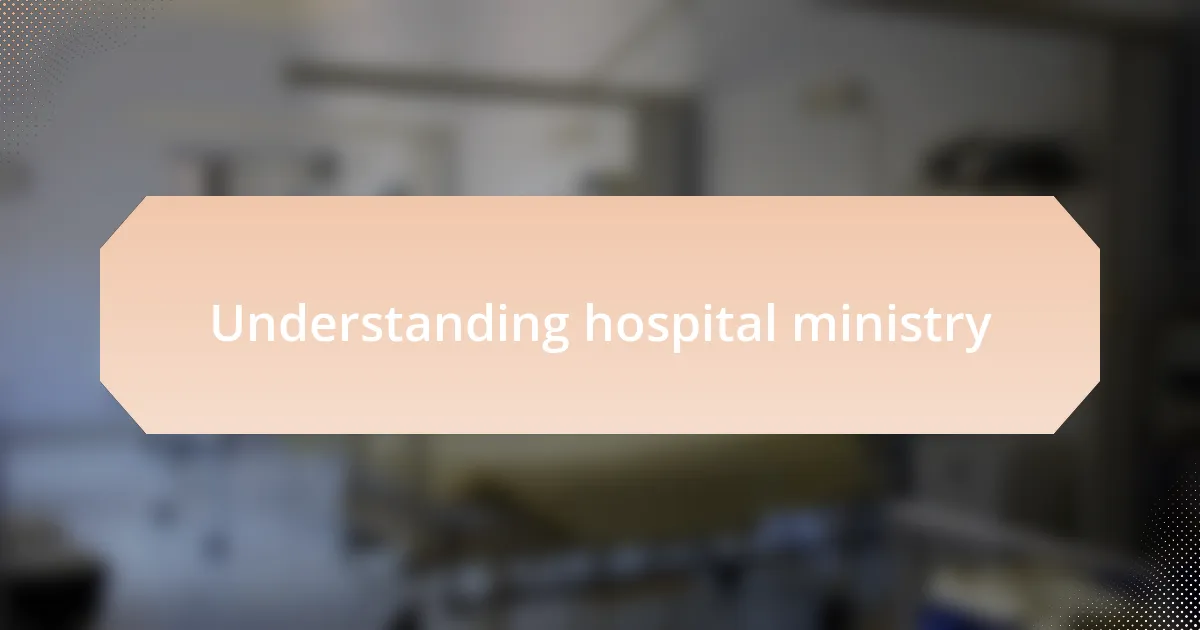
Understanding hospital ministry
Hospital ministry is a unique blend of spirituality and healthcare, where compassion meets the clinical environment. I remember walking into a patient’s room one day, sensing an overwhelming need for emotional support amid the sterile surroundings. At that moment, I realized how vital it is to offer not just prayers, but also a listening ear and a caring presence.
In this ministry, understanding patients goes beyond their medical needs; it involves connecting with their fears and hopes. Have you ever found yourself sitting with someone and feeling their anxiety? I have. It’s those moments when I actively listen and acknowledge their struggles that allow me to build rapport and, ultimately, provide comfort that science alone cannot offer.
Moreover, hospital ministry often serves as a bridge for patients to confront their beliefs during a vulnerable time. I once spoke with a patient who expressed confusion about faith and healing. Those conversations can shape one’s understanding of life and death, prompting questions that linger long after a hospital stay. Engaging with patients on this level isn’t just fulfilling; it’s a profound reminder of the spiritual dimensions that accompany physical healing.
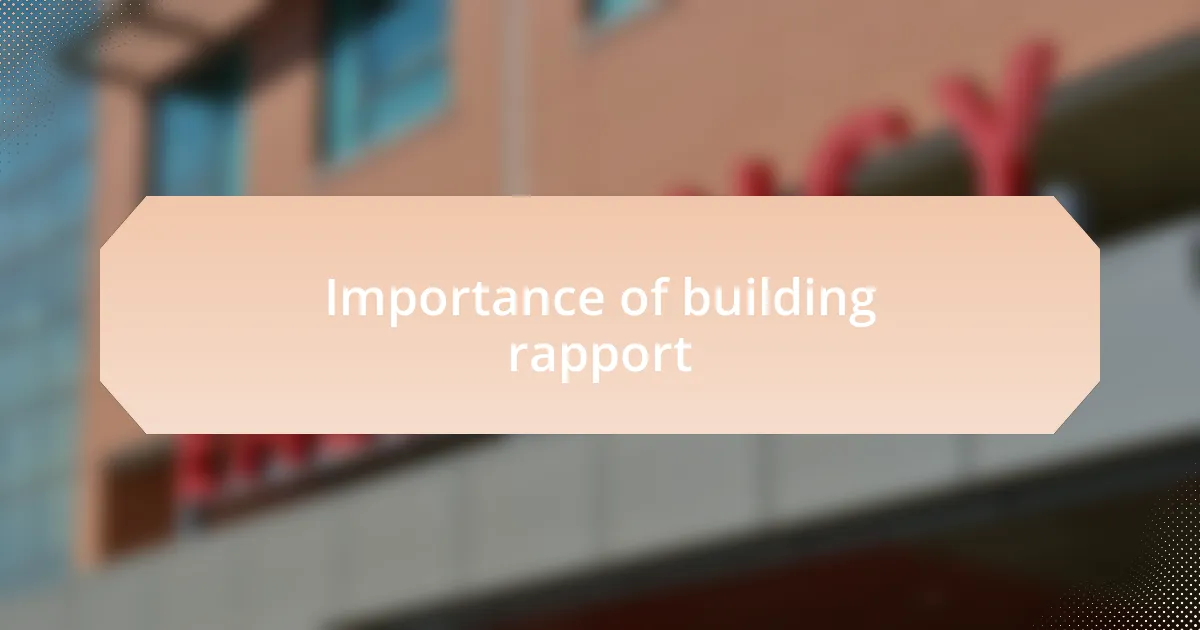
Importance of building rapport
Building rapport within the hospital environment is essential for fostering trust and open communication. I recall a time when a patient was hesitant to share their concerns about treatment. By simply sitting down, maintaining eye contact, and expressing genuine interest, I noticed how their demeanor shifted. That subtle connection allowed them to reveal fears they had been holding onto, ultimately leading to a more tailored approach to their care.
The emotional landscape in which a patient exists can significantly impact their healing process. When I reflect on the patients I’ve worked with, those who felt a personal connection, even in brief interactions, often spoke of feeling more hopeful. Isn’t it remarkable how a few kind words can transform someone’s entire outlook during a challenging time?
Moreover, establishing a solid rapport can directly influence patient outcomes. For instance, I’ve observed that after building a connection, patients tended to adhere more closely to their treatment plans. This makes sense, doesn’t it? When individuals feel valued and understood, they’re more likely to engage in their care actively. It’s a powerful reminder that rapport isn’t just a nicety; it’s a fundamental part of effective healthcare.
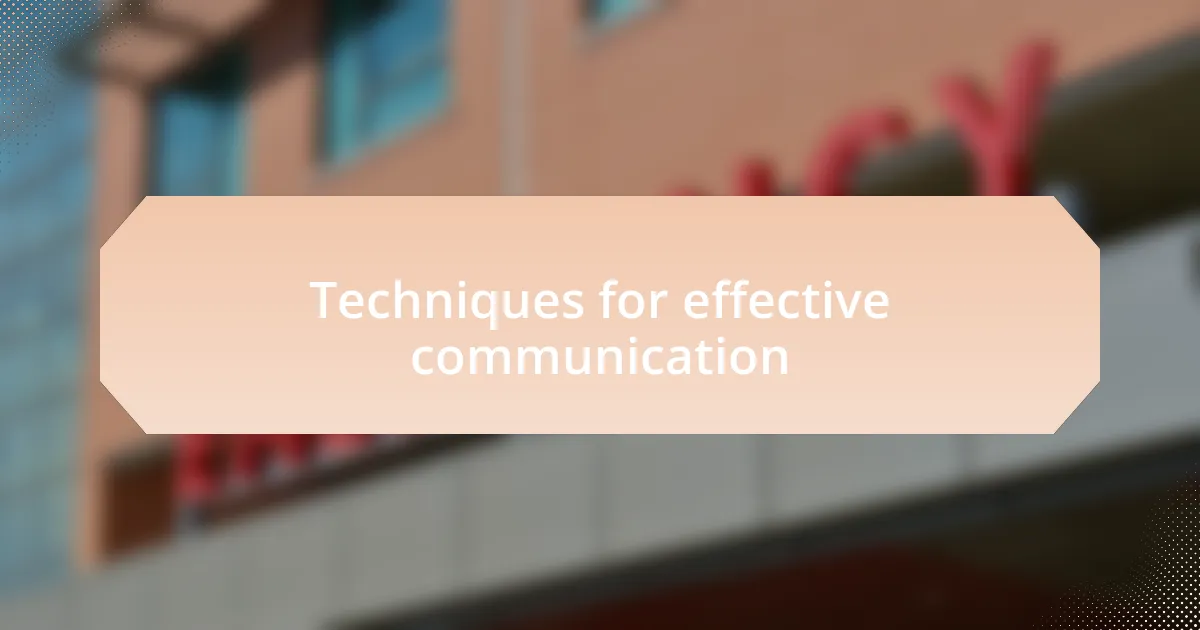
Techniques for effective communication
Effective communication begins with active listening. I remember during a difficult consultation, I decided to give the patient my full attention, nodding and paraphrasing what they said. This not only reassured them that their emotions mattered but also encouraged them to express deeper concerns. Have you ever felt truly heard? That’s the magic of listening—it creates a space for openness and vulnerability.
Using open-ended questions has consistently proven invaluable in my practice. I often start with phrases like, “Can you tell me more about that?” which invites patients to elaborate on their feelings and experiences. This technique not only empowers them but also helps me gather vital information that could influence their care. It makes me wonder how much more we could uncover if we simply ask the right questions.
Moreover, non-verbal communication plays a critical role in how messages are perceived. I’ve found that leaning slightly forward and using appropriate facial expressions can convey compassion and understanding even before I say a word. Have you noticed how a warm smile or a gentle touch can change someone’s day? By mastering these techniques, we create an environment where patients feel valued, ultimately enhancing the healing process.
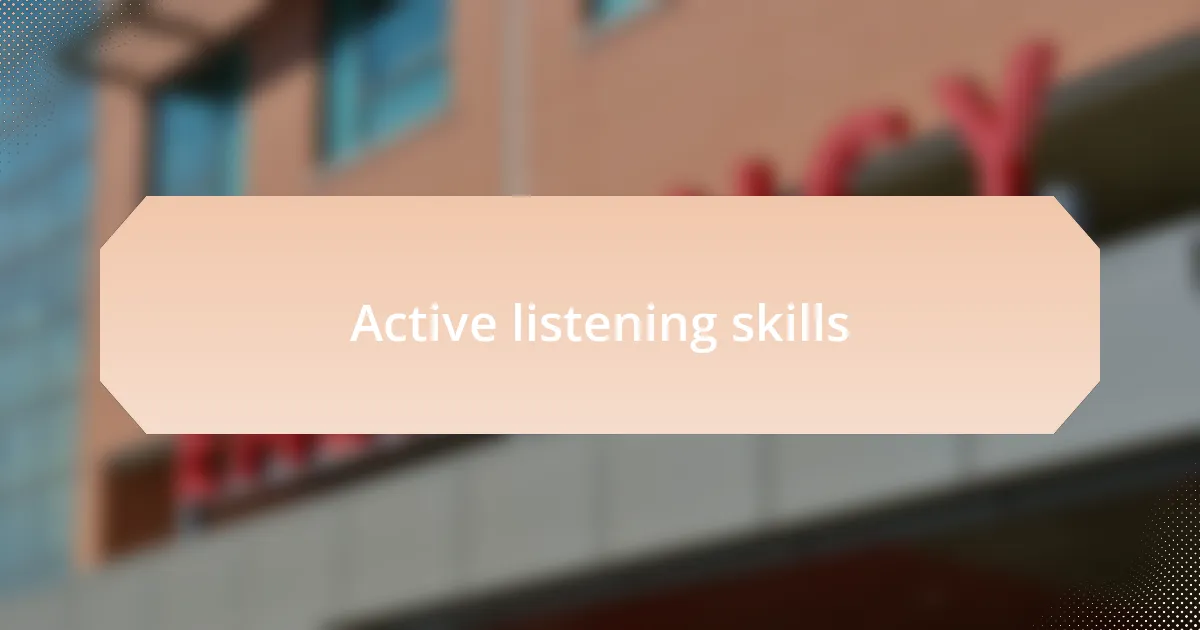
Active listening skills
Active listening is not just about hearing words; it’s about being fully present. I recall a time when a patient shared their fears about a diagnosis. Instead of jumping in with solutions, I focused intently, reflecting back their feelings. This approach not only strengthened our connection but also allowed them to navigate their emotions more freely. Have you ever noticed how being truly present can transform a conversation?
The nuances of active listening extend to the small details, too. There was a moment when a quiet patient mentioned their favorite hobby amid discussing their health concerns. I took that hint, engaging them about their passion and discovering how it provided them comfort during tough times. It’s fascinating how these seemingly minor details can reveal layers of a person’s life, helping me understand them better. How often do we miss such opportunities by simply waiting for our turn to speak?
Incorporating pauses into conversations can also be a powerful active listening tool. I remember patiently allowing silence to linger after a patient shared something deeply personal. It felt somewhat uncomfortable at first, but I soon realized it gave them the space to reflect and share even more. Have you experienced that shift when you let silence speak for itself? It can be profound, as it not only shows respect but often invites individuals to dive deeper into their thoughts and feelings.

Empathy in patient interactions
Empathy is truly the heart of patient interactions. I remember a time when a patient expressed their anxiety about undergoing surgery. Instead of only reassuring them with medical facts, I chose to sit beside them and share some of my own experiences of feeling vulnerable. This moment not only eased their worries, but it reinforced our bond, showing them they were not alone in their fear. Have you ever seen how sharing your own humanity can break down barriers?
When I approach a patient’s concerns, I aim to understand not just their words but the emotions behind them. During a past visit, a patient dismissed their pain, insisting it was “nothing serious.” By gently probing deeper, I discovered a layer of fear tied to past experiences. It was in that conversation that empathy began to flourish—we were able to address not only their physical ailment but also the emotional baggage influencing their health. What’s your experience when you dig a little deeper into what people say?
Sometimes, a simple gesture can convey empathy more than words ever could. I once held the hand of a patient who was sobbing quietly after receiving distressing news. No words were needed, just that brief touch to communicate understanding and compassion. The power of human connection in these moments goes beyond any treatment; it affirms our shared experiences of pain and healing. Have you noticed how these small actions often speak volumes?
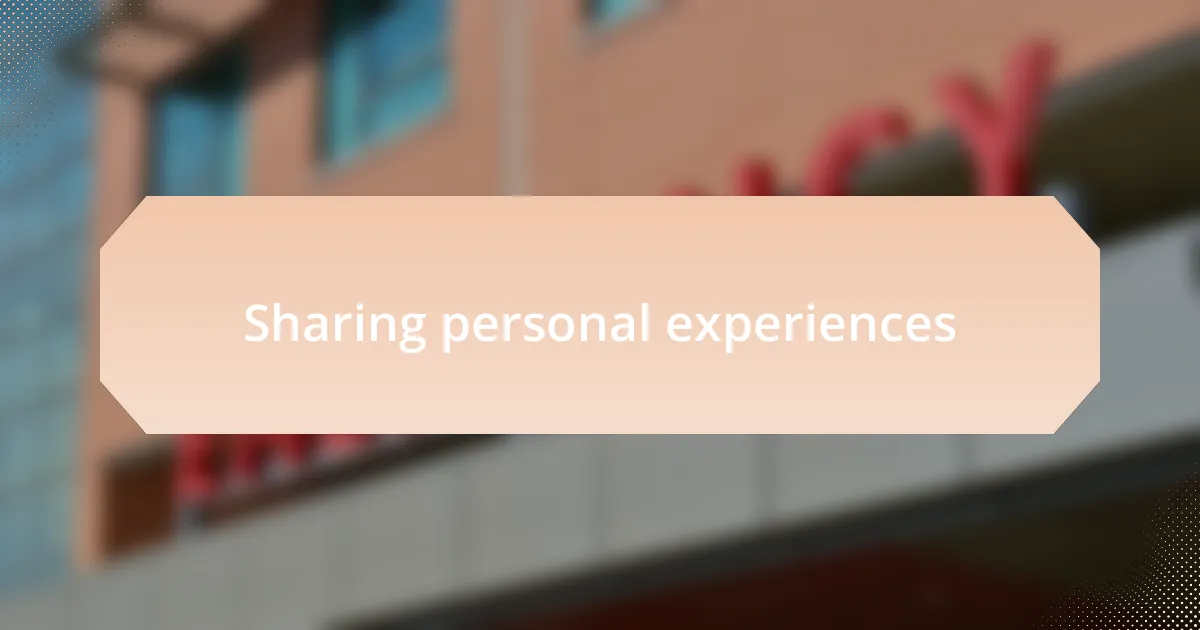
Sharing personal experiences
Sharing personal experiences can transform patient interactions into profound connections. I recall a time when I confided to a patient about my own struggle with medical issues. As I shared my fears and uncertainties, I could see their eyes soften. It was as if my vulnerability had created a safe space for them to express their own concerns. How often do we underestimate the power of simply being real with one another?
In another instance, while discussing a life-altering diagnosis, I revealed how I once faced a similar crossroads in my own life. I spoke candidly about my initial feelings of helplessness and how I, too, leaned on others for support. This story resonated deeply with my patient, and it opened up a dialogue that allowed them to voice their own fears. Isn’t it remarkable how our experiences can bridge the gap between caregiver and patient?
When I took a moment to share a light-hearted memory from my childhood—about a time when I faced setbacks yet found joy in small victories—it sparked laughter that filled the room. In that moment, I witnessed a transformation in their demeanor. Rather than feeling weighed down by their diagnosis, they experienced a flicker of hope and connectedness. Have you ever noticed how shared laughter can lighten even the heaviest burdens?
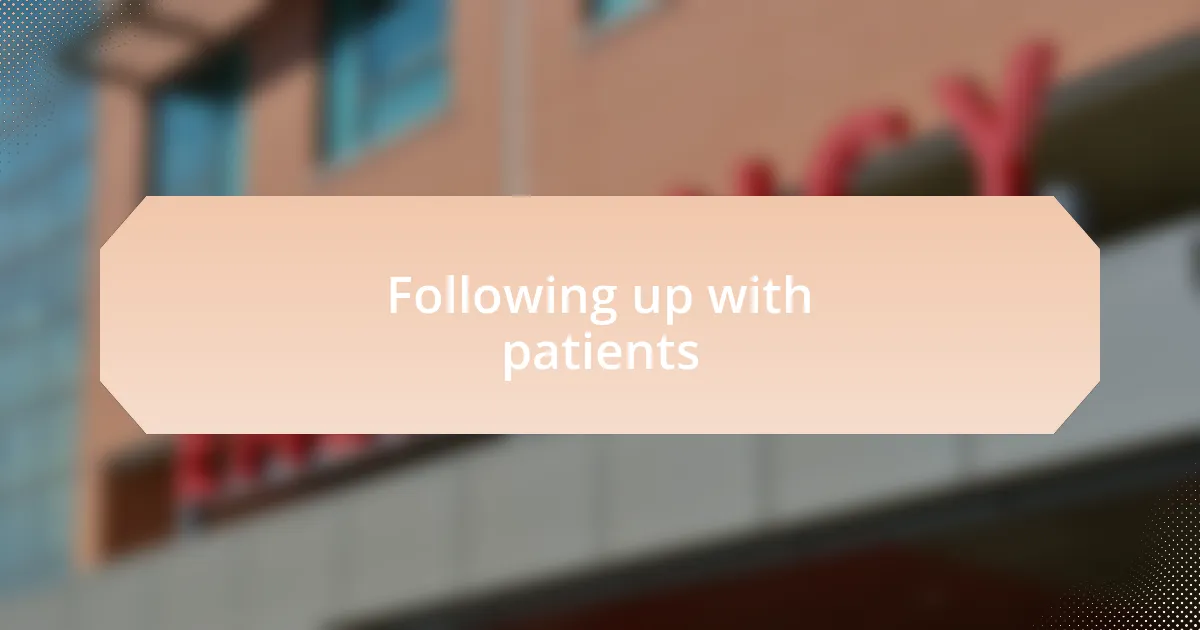
Following up with patients
Following up with patients is a crucial aspect of building rapport that cannot be overlooked. I remember a time when I made a simple phone call to check in on a patient after their discharge. They were surprised but grateful, sharing how lonely they felt after leaving the hospital. That call not only reaffirmed their support network but also deepened our relationship, showing them that their well-being truly mattered to me.
In another instance, I sent a handwritten note to a patient who had undergone a difficult procedure. I included a personal touch by mentioning a specific detail from our last conversation. When they responded, they expressed how touched they were to receive such a thoughtful gesture. It made me realize how these small acts of kindness can provoke powerful emotions and foster a sense of community, even when I’m not physically present.
I often think about the importance of consistency in these follow-up interactions. Regularly reaching out can create a sense of security for patients navigating their health challenges. It’s remarkable how just knowing someone cares can boost their morale. Have you ever considered how a phone call or a handwritten note could uplift someone in their time of need? These connections transform our roles, making us not just caregivers but trusted companions on their journey.